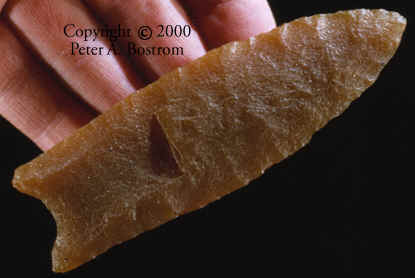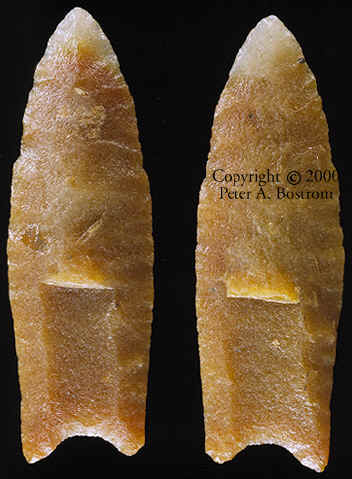|
EASTERN
STYLE
CLOVIS POINTS
10,000 to
8,900 B.C.
There are several
obvious differences between many of the early fluted points found in the
eastern United States as compared to examples found in the west. Even
though most of these points are generally called Clovis by everyone except
a few archaeologists who are specializing in the study of Early Paleo
Indian stone tool technology, there are major differences. The differences
might be compared to the Dalton Culture's projectile points and knives,
but not as exaggerated. For example, there are many different styles of
Daltons but they also vary in size from about 1/2 inch to 15 inches. The
same can be said with Early Paleo-Indian fluted points. They also vary in
size from about an inch to close to 10 inches and they also have several
style variations.
Clovis is still the oldest recognized cultural tradition and
point type. But it is generally believed that there are older sites that
were once occupied by even earlier cultures. Some archaeologists are
theorizing that these people may have arrived here from the east while
traveling across the north in small boats. The traditional view has always
been that they came across land west of Alaska created by a lower ocean
level during a period of glaciations. Many of these early sites, if they
exist, are now probably underwater along the continental shelf where at
one time approximately 2.2 billion acres were then above water!
|
|

CAST #P-4
EASTERN
STYLE
CLOVIS POINT
Fulton County, Illinois
Maury Meadows Collection
This Clovis point was found in 1981 by Ronald Beaird in Buckhart Twp. in
Fulton County, Illinois. It was an isolated find and no other artifacts have
been found on this site.
This Clovis point has several distinctive traits that are seen
on many of the early fluted points found east of the Mississippi River. For
example, this point has a steeply concaved base that gives it sharper
"ears" than the "classic" western type. The edges are slightly recurved or "fishtailed" unlike the contracting bases
of many western examples. Both sides of this point also have very large,
wide and long channel flake (or flute) removals unlike the multiple flake
removals on most western fluted points. Plus there are no edge-to-edge or
large percussion flake removals on this point as compared to many of the fluted
points found in the western United States.
The most striking characteristic of this point is the
semi-translucent orange material it's made of. The material is called Hixton
which is a Silcified Sandstone that was originally collected on
exposed sites in Wisconsin. This is one of the prettiest Clovis points I
have seen. It's also a good example to illustrate one of the traits that
help to identify a Clovis site. The Clovis people utilized the best cherts
and chalcedonies to make their tools which also sometimes included the most colorful
materials. The most exotic material Clovis people liked to use from
coast-to-coast was optically clear quartz crystal.
This point measures 4 1/16 inches long.

CLOVIS POINT
This picture
show both sides of the original artifact.
|

